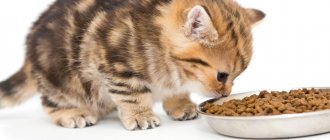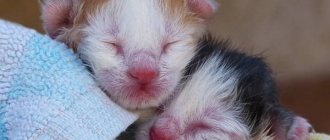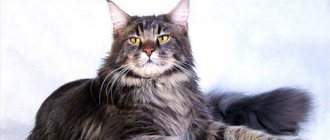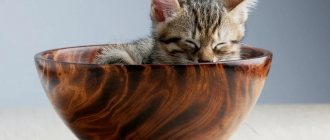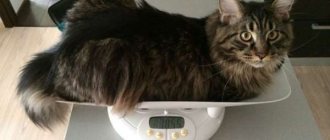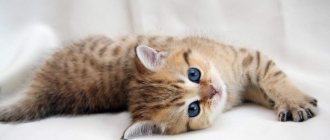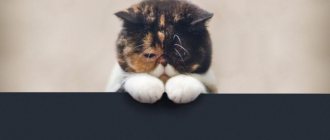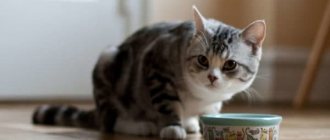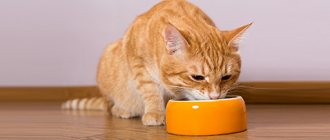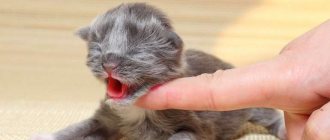What should you not give?
Most people think that cats' favorite food is milk and sausages.
In reality, everything is much more complicated. For a cat to be healthy, it must be taught a proper balanced diet from childhood. In addition to food that must be present in a kitten’s diet, there is a list of foods that are undesirable for consumption.
- Liver. It contains a huge amount of vitamin A and D. If this product is regularly fed, the animal’s body will become oversaturated with vitamins, which can lead to negative consequences. At the same time, pampering a kitten with liver is not prohibited. It can be given several times a week as a vitamin variety.
- Economy class dry food. Of course, they attract many breeders because they are inexpensive, but they contain a huge amount of harmful substances that, if consumed for a long time, negatively affect the health of the animal. Just look at the cost of dyes and all kinds of preservatives.
- Food made from legumes. They cause constipation and bloating. It acts on the cat's body and potatoes according to a similar principle.
- Fish. When a kitten is constantly fed fish products, the animal develops urolithiasis. To avoid such consequences, fish should be given no more than twice a week. And kittens under the age of one month should not be fed fish at all.
Below is a list of foods that are hazardous to a kitten’s health.
- Pickles, smoked meats, fatty and spicy foods. They contain a huge amount of seasonings that can harm the kitten’s intestinal microflora.
- Raw meat. This product can be included in the diet of kittens over 5 months. Younger cats need to boil meat products.
In this case, it is proposed to consider products that can lead to the most tragic consequences - death. Moreover, the death of the animal will not occur immediately, but after a certain period of time.
- Sweets. For a small kitten this is real poison. The animal's body by its nature is not adapted to eating chocolate. It’s good that not every individual eats candy or cookies.
- It is very dangerous to give fish skeletons and bird bones to a kitten. Their structure, when chewed, can cause irreparable harm to the animal’s body. When a cat chews bones, pieces of the skeleton break up into fragments with sharp ends. They get into the stomach, and accordingly, they can scratch the esophagus or even puncture it, which leads to internal bleeding.
- Expired products. Any food that has long expired is a breeding ground for many pathogenic bacteria and putrefactive microorganisms. This food will not lead to anything good, especially if you feed it to a small kitten.
The information presented will help novice breeders feed a newborn kitten and raise it into a healthy adult cat.
In the next video you can find out what breeders feed small kittens.
Tips on how to distinguish a cat from a cat
Primary signs of sex in cats can be distinguished from birth. You can examine the kitten yourself, tactilely or visually. In the first case, you need to wash your hands thoroughly, make sure they are not cold, and place the kitten in your palm. If the baby is wary or worried about something, it is better to leave the check. The second way is to simply look at the genitals and anus. In a male they closely resemble a colon, while in a female they resemble an exclamation point. In addition, cats can boast of quite thick hair between these “points”, unlike female cats. Experienced cat lovers can determine gender by the shape of the face and body:
- the cat has a wider muzzle and nose;
- his physique is more massive, his paws are thicker;
- the cat is more graceful;
- Cats have an elongated muzzle.
Boy and girl
Calico cats are almost always (with very rare exceptions in the form of a genetic disease) cats, since the calico gene is associated with the X chromosome, which only girls have. When kittens are four to five months old, they begin puberty and their hormonal levels change dramatically. They may ask to go outside and meow loudly. Males tend to mark territory and may try to mate with females. Females can experience all the delights of the first heat, during which, under the influence of awakened hormones, they begin to scream loudly, rub their muzzle against the owner’s legs, and squirm. However, it should be remembered that early pregnancy is undesirable for a cat.
Features of care
Small pets at 2 months are still very fragile creatures and are susceptible to various infections and parasites. It is necessary to especially carefully monitor their health, give them vaccinations at the right time, and carry out deworming. If you have any concerns or concerns regarding nutrition or health, please contact your veterinarian immediately. Observe the appearance and behavior of your pet: it should be well-fed with shiny fur and active in games
Particular attention should be paid to the constant availability of fresh water for the kitten, especially when feeding with commercial food.
Show your teeth baby
A good way to understand how old a kitten is is to examine its teeth. To do this, you need to carefully, without using force, spread the kitten’s jaws and examine the oral cavity. Up to two weeks, kittens have no teeth at all, then the incisors begin to cut. Primary canines erupt in the third to fourth week, and premolars in the fourth to sixth week. If the kitten has a full set of teeth, but they are not molars, the kitten is approximately four months old. Should be:
- six incisors on both jaws;
- two fangs above and below;
- three premolars above;
- two premolars below.
Baby shows teeth and character
If your pet chews on things and furniture upholstery, this may be due to teething. If the kitten already has large teeth, it is about four months old or older. There will be 26 milk teeth in total, and in a year and two months they will be replaced by permanent teeth, and four more molars will be added to their number.
Formative nutrition: from the first month to six months
Now all the sleepless nights are over and your kittens begin to confidently stand on their feet, get out of the nest, bully each other, run to the kitchen in search of food - in a word, the body has survived and its active formation has begun. During this period, the main body weight gain occurs. Every day the kitten asks for more and more food, sometimes it becomes capricious, turns up its nose, and sometimes it devours the entire portion; all you have to do is replenish the bowl.
At this age, breeders should provide the baby with food in sufficient quantities so that he always has enough energy for development and play. In addition to calories, during this period of life a kitten needs to consume all the building material from which its body will be formed, and, consequently, its future health. To do this, breeders begin gradually feeding babies a wide variety of foods.
The calculation of the number of feedings during this period is still determined by weight. Now 1 kg is taken as a basis. The daily dose for a kilogram kitten is 150-250 grams of a balanced diet. This means that your daily intake should include proteins, vegetables, cereals and fermented milk. Moreover, in the first month their ratio will be more towards liquid mixtures, and by the fifth month the diet should already contain more meat products. The most common scheme looks like this:
- 1st and 2nd months - 5 meals a day: every 4 hours, skipping one night feeding (break 8 hours);
- 3rd and 4th months - 4 meals a day: every 4 hours, skipping two night feedings (12 hour break);
- 5th and 6th months - 3 feedings per day.
Although the kitten eats less and less every month, this does not mean that it needs to be fed less and less. In no case! On the contrary, now is the time to eat a lot, even more adult cats. It’s just that now the portion size should increase, since the kitten’s stomach expands every day. It is no longer a problem for your baby to fit the right amount of food into it at one time. In the morning, it is advisable to give fermented milk, in the afternoon - mixtures of cereals, vegetables and meat, in the evening - meat products (so that the hunter sleeps at night and does not look everywhere for the treasured game).
When furry pets open their eyes
You can quite accurately determine how old a kitten is by examining its eyes. Kittens are born blind and usually open their eyes on the tenth to twelfth day, but not earlier than a week after birth. In healthy kittens up to two weeks old, the eyelids are tightly closed or slightly open, and there is no opaque discharge. At the same time, the eyes will remain cloudy and bright blue for some time, and only then will they begin to change their color to “adult” - unless the breed of cat assumes that they will remain blue-eyed (Angora, Siamese, British and others). Blue eyes mean that the kitten is not yet two and a half months old. Typically, the eye color of cats is green or yellow, sometimes amber. The color is finally established by the age of six months. You can also look at the babies' ears. At birth, kittens' ears are pressed tightly against their head, as kittens are born with closed ear canals. They open no earlier than the fifth day of life, and the kittens begin to hear; The ears lift completely in the second or third week.
Feeding standards
The amount of food per meal depends on its type and type of feeding. Veterinarians recommend keeping domestic cats on a natural diet, regularly using vitamin and mineral supplements, and following a two-time feeding regimen (morning and evening).
An adult healthy animal should be provided with at least 10 g of protein, 2 g of fat, 1 g of carbohydrates, 1 g of fiber per 1 kg of weight per day. The daily energy value for natural feeding should be at least 40 kcal per 1 kg of weight.
If the owner buys ready-made food for his fluffy dog, he must strictly adhere to the dosage indicated on the packaging. Finished products of different brands differ in the quality of raw materials, preparation technology, and composition. For example, for a healthy adult cat weighing 4 kg, the average amount of dry food per day is 60-70 g, divided into two meals.
Important! Depending on the composition of the feed, its purpose and class, the dosage may differ slightly for animals of the same weight category. The higher the product class, the lower the feed consumption
All ready-made food is completely balanced and nutritious. Premium, super-premium or holistic products undergo numerous quality checks, are safe for animals and are economical.
Super-premium and higher class food is most suitable for the animal
The main parameter by which the required amount of ready-made food per day is determined is the weight of the animal. To ensure full life activity, per 1 kg of adult weight there should be 30-60 g of food containing 60-70 kcal.
Below are tables showing how much dry and wet food a cat needs per day:
How much dry food do you need per day?
Related questions
Below are brief answers to common questions from kitten owners.
When do eyes appear?
The first slits in the blind eyes of a newborn kitten appear by the end of the first week.
When do the eyes open?
The baby's eyes open between 10 and 14 days.
When do eyes change?
By the end of the third week, the eyes begin to change color.
How long does a one-month-old kitten sleep?
A one-month-old kitten sleeps for at least 18 hours a day.
How to distinguish a cat from a cat?
How to distinguish a cat from a female cat
Noticeable gender differences are formed in kittens by 12 weeks; before that, it is quite difficult to distinguish a female cat from a female cat. In males, the distance from the anus to the genitals is greater than in females. The male's testicles can already be seen and felt.
Ready diet
With a ready-made diet, Abyssinian kittens are fed wet, dry, semi-moist industrial food, canned food, and high-quality pates. The prepared diet should be varied. You should not feed your pet only, for example, dry food or wet food. Combine dry pads with canned food, pates, and treats for kittens.
Advantages of ready-made diets:
- no need to waste time preparing a varied menu for the cat;
- the brand line includes food for kittens of various age groups;
- dry food has a long shelf life;
- the manufacturer indicates the approximate daily allowance by age on the packaging;
- large selection of flavors.
The line of well-known brands also includes products for weakened animals, for kittens with a sensitive gastrointestinal tract, and pets prone to food allergies.
The best food for Abyssinian kittens:
- Royal Canin.
- Hill's.
- ORIGIN.
- Acana.
- Nutra Gold.
High-quality feed has a balanced composition and contains all the necessary nutrients, vitamins, microelements, and amino acids. Holistics are intended for nutrition of Abyssinian kittens with sensitive digestion. Contains probiotics and enriched with B vitamins.
Ready-made feed
The opinions of veterinarians regarding which food to prefer - natural or ready-made specialized food - do not coincide. The main advantage of ready-made food is that there is no need to introduce special complementary foods, as with natural nutrition, since it already contains fortified supplements. But there is also a significant drawback - the addition of flavors and preservatives, which can harm the health of babies.
If you decide to feed your pet prepared food, you need to remember the rules:
- Do not mix dry and wet food together;
- stick to a particular brand of food and change it only if absolutely necessary.
When choosing ready-made food, you need to carefully study the products of manufacturing companies. Find out whether it is possible to use their food, combine dry and wet canned food, and in what quantity to give them. According to veterinarians’ recommendations, from four months onwards, a kitten can be given the entire daily portion at once: it already knows how to control the amount of food it eats. It is better to pour wet canned food in sauce and jelly in the quantity required for a single meal. In case of a possible combination, the daily diet of a pet, according to the recommendations of experts, should consist of 3 quarters of dry food and 1 quarter of canned food.
Without causing harm to the baby’s health, you can use the following foods:
Acana
One of the best proven super premium food series. It provides a complete balanced diet and is the best hypoallergenic food. The food is produced in its own juice. The composition includes only whole and fresh ingredients. It contains meat ingredients, vegetables, fruits, seaweed, fresh eggs, polyunsaturated fats, proteins and proteins in optimal quantities.
Royal Canin
Dry food from this company is the best substitute for natural food, as it contains the substances necessary to maintain the life and activity of a kitten. The brand’s “medicinal” line is especially popular. The composition of veterinary feeds from this company is ideally balanced and takes into account the characteristics of a particular disease. Suitable food for kittens aged 4-12 months.
Vitamins and supplements
When kept on high-quality, industrial feed, vitamins and additives are not required
It is important to understand that an excess of vitamins and microelements is no less dangerous than their deficiency. With a natural feeding method, vitamin supplements should be present in the diet on an ongoing basis at least until the age of one year.
A kitten can get basic vitamins and nutrients from natural products:
- Meat and bone meal.
- Fish, chicken, beef liver.
- Greens, vegetables, fruits.
- Sunflower oil, olive oil.
- Brewer's yeast.
Taurine is a rare amino acid that is found in small quantities in:
- Turkey.
- Rabbit.
- Chicken heart and liver.
- Beef heart.
- Pork, after deep freezing.
- Boiled pork liver.
- Ocean fish and shellfish.
- Raw red fish.
- Live homemade yogurt.
- Whole milk.
Do not forget that pharmaceutical products are also sources of vitamins and nutrients:
- Fish fat.
- Feed tricalcium phosphate.
- Omega-3, Omega-6.
- B vitamins.
To make life easier for owners, stores and veterinary pharmacies sell basic vitamin complexes containing essential nutrients and taurine. Veterinarians recommend choosing several complexes with a short composition, but alternating them on an ongoing basis.
Vitamins and supplements
A kitten's growing body must receive all the vitamins and mineral supplements necessary for health and development. There are complexes on sale designed for kittens starting from 2-3 months of age. It is best to use complex preparations (Gamavit, Tetravit, Trivit). At the same time, we note that vitamin supplements are necessary when keeping a pet on a natural diet. High-quality industrial feeds have a completely balanced composition and already contain all useful substances.
From available means, the diet is enriched once a week with fish oil (one drop for each feeding), dry yeast, and meat and bone meal.
Why monitor your kitten's body weight and size?
An important parameter when breeding and keeping a pet is its weight. Deviations from the norm can indicate developmental defects or health problems. It is important to monitor weight gain from birth and throughout life. The weight of a kitten at 3 months or a year, if left unchecked, can affect the future development of body weight in an adult cat. Excessive feeding contributes to obesity, while malnutrition contributes to a deficiency of vitamins and microelements important for the functioning of the body. The size of the cat in the future depends on proper nutrition.
Feeding rates depending on age and weight
Until the age of six months, the kitten gains 100 grams of weight per week. At six months, the animal’s growth stops, but its weight continues to increase. However, these indicators do not apply to each individual, since there are breed characteristics. For example, the final weight and size of a Maine Coon is established only at two years, and until this age a pet of this breed grows quite slowly.
The older a kitten gets, the less energy its body expends, which means that as it grows, the amount of daily food should be reduced. So, if a very tiny baby needs 48 g per 1 kg of weight per day, then from 4 months this portion decreases to 32 g per day, and from 7 months this figure is completely equal to 24 g. To accurately calculate the feeding rate, you can use with a regular measuring cup. It is sold at the pet store.
Changes in a kitten's behavior from 3 to 6 months
Kittens sleep a lot when they are first born, but as they grow, they will spend less time sleeping and more time playing and exploring.
Between three and six months of age, a kitten is brave enough to test its physical limits by putting things in its mouth and approaching other animals to see what will happen.
The first few months of socialization with its littermates and mother will pay off over the next three months as you begin to see the kitten's personality develop. If he has not received adequate socialization, he may develop problems with aggression.
Teething is for kittens of this age. Chewing furniture, toys, and even certain items that a kitten shouldn't chew is an attempt to help baby teeth fall out.
This behavior should be allowed but limited to safe toys. Kitten proofing your home is often necessary to keep items such as electrical cords out of your home, as well as to keep your belongings away from your kitty's tiny but sharp teeth and claws.
Most kittens are sexually mature by the time they reach six months of age, but the age can vary from cat to cat based on breed.
Once a cat reaches sexual maturity, she may begin to act differently due to the hormones that circulate in her body. Female kittens may exhibit behaviors such as crying and raising their tail in the air, while male kittens may become more aggressive.
Spaying or neutering your kitten will eliminate the behavior caused by hormones.
Are there any peculiarities in feeding small kittens of different breeds?
Feeding different kittens may vary depending on the breed.
Caring for any breed has its own nuances. For example, it is not customary to give liver to babies of Russian Blue cats and Gray Nibelungs. It is believed that this product gives the fur a brown tint, although many breeders recommend feeding kittens with liver from at least one and a half months. It is recommended to feed British kittens a nutritious diet. Britons are stocky animals, kittens grow quickly, rapidly gaining weight, but these animals cannot be called lazy. The diet of such a kitten should contain at least 65% meat products, and vegetables - about 25–30%.
Scottish kittens (Scottish Folds and Scottish Straights) under 3 months of age should eat at least 6 times a day. Active cats quickly begin to feel hungry. Some owners of Scottish cats note that the more nutritiously you feed the kitten, the better its coat “fills up.” I had to read recommendations and advice on feeding Scottish cats on forums. One breeder wrote that the more difficult it is to prepare porridge (4-5 grains at a time), the thicker the animal’s fur becomes. And some even choose a mixed type of feeding. Moreover, kittens are given high-calorie foods as an additive to store-bought food.
Scots need to be fed often and nutritiously
There is a lot of controversy about the nutrition of small Maine Coons. However, every breeder recommends closely monitoring the baby’s diet. Cubs grow large; a three-month-old kitten can be the size of a regular adult cat. The food for such cats should be dense and plentiful, but the kitten should not be overfed (regular overfeeding leads to obesity and other problems).
With ready-made food, everything is much simpler. Manufacturers of elite baby food take into account the characteristics of breeds. For example, Royal Canin, which produces food for 6 different breeds of kittens, has developed the British Shorthair series. This food is presented in the form of large granules of a special curved shape. The busy British cannot swallow such an “inconvenient” faction; they have to chew it. In addition, the packages of store-bought food always indicate the daily intake for a kitten, the volume of a single serving and other details.
What can a kitten weigh at birth?
The weight of a kitten at birth can depend on various characteristics:
- Gender. At the moment of birth, a cat may not differ in weight from a female cat, but this difference becomes noticeable after some time. Males are usually a little larger than female cats, and therefore weigh a little more.
- Number of kittens born. It has long been noted that the more numerous the litter, the greater the underweight of each individual.
- The completeness of the diet of a mother cat during pregnancy.
- Belonging to a certain breed. For example, a Maine Coon kitten at the time of birth will weigh more than a baby, for example, of the Siamese breed.
Newborn kittens of large breeds (for example, Maine Coons) will weigh more than their graceful relatives
A newborn kitten most often weighs no more than one hundred and twenty grams. He is still blind and mostly immobilized. All he can do is eat, grow and get enough sleep. Staying in this mode, the baby can gain up to 15 grams per day.
The need for water in the diet
Water plays a key role in a pet’s diet, since the full functioning of metabolic processes and hematopoiesis depends on the water-salt balance. If metabolic processes in the body slow down, the development, growth and functioning of all organs slow down along with them. Thick blood is one of the reasons for slow metabolism, problems in the functioning of the cardiovascular system and other organs.
Make sure that drinking bowls with clean water are available to your pet at all times, especially if he eats industrial food. The water in drinking bowls should be changed at least once a day, in hot weather 2-3 times a day. Be sure to wash bowls to remove plaque, as it is a source and fertile ground for the proliferation of pathogenic bacteria.
How much should a cat eat per day?
To keep your pet healthy and alert, its diet must be nutritious and balanced. It is the nutritional value of the product that determines how many times a day you need to feed your cat. The amount of food eaten during the day should be no more than 7.5% of the animal’s weight.
The dosage of ready-made food is indicated on the packaging, and with natural feeding, the cat needs to eat up to 150 g of meat or fish per day, which is 50% of the daily protein intake. The natural diet is supplemented with fermented milk products, cereal porridges, seasonal vegetables, vitamins and mineral nutritional supplements. Meal frequency – 2 times a day.
- Can I have a piece?
The diet of a pregnant cat should have an increased energy value: contain more vitamins and minerals, but not increase the calorie content of the product. Increase the frequency of feedings up to 4-5 times, maintaining the usual serving size. A nursing cat is also provided with frequent feeding, while increasing the volume and calorie content of food.
Note! It is better to prepare the diet for a pregnant or lactating cat after consultation with a veterinarian
Reasons and methods of determination
There are several reasons why determining the age of a pet is a necessary procedure. Firstly, this is necessary to choose the right diet and create a diet - small kittens need to be fed more often than older ones. Secondly, it is necessary to know the baby’s age in order to schedule vaccinations and medical procedures, as well as to calculate the dosage of vitamins and medications. Thirdly, this information is needed in order to prepare for the baby’s growing up - to purchase a scratching post and toys in time, to prepare the cat for castration surgery, and so on.
Finally, knowledge about the age of the pet is necessary for its proper socialization . This period begins in the second week of the animal’s life and ends in the seventh or eighth. During this time, it is very important to let the kitten get used to people (and, if necessary, other animals), otherwise he may remain wild and aggressive for the rest of his life.
The easiest way to find out the age of an animal is to ask the breeder, previous owner or employees of the nursery where the pet previously lived. This way you can get the most accurate information and find out the kitten’s date of birth down to the day. But if a pet was picked up from the street, determining its age can become problematic. For this purpose, I use several methods - weigh the animal, examine its teeth and determine whether it has entered puberty.
If you can’t figure out the kitten’s age yourself, you can ask the veterinarian about it at the first examination. A qualified doctor knows the most accurate and reliable methods. In addition, he can give recommendations on caring for the animal and refer it for appropriate tests and vaccinations.
Water in a kitten's diet
Water plays a fundamental role in metabolic rate and the process of hematopoiesis. If dehydrated, a one and a half month old kitten can die within a few hours. Before switching to adult food, make sure that the kitten knows how to drink water and does it willingly. Every time after eating, make sure that the kitten goes to the drinking bowl.
If a one and a half month old kitten does not drink water, the reason may be that he does not know how to do it. To teach your kitten to drink from a bowl, wet your finger and gently touch the kitten's nose. The baby will instinctively lick his face and if he is thirsty, he will become interested in the contents of the drinking bowl.
Why is it important to know the kitten's age?
Experienced breeders and veterinarians can tell a kitten's age without having exact dates. The process of socialization in kittens begins around two weeks of age and continues until almost two months. It is at this time that you can understand how playful or reserved the kitten is, and how it will get along with people. If the animal has a wild or aggressive character, most likely this will not change in the future.
Kittens of any age are adorable, no matter what breed they belong to. However, it is very important to know when they were born in order to provide them with the correct care and care. As a rule, five signs are enough to independently determine the age of a kitten:
- body size and proportions;
- color and shape of eyes and ears;
- pet's weight;
- number and condition of teeth;
- behavior and activity.
How many times a day should I feed?
Since the small kitten is still small, it is important to provide the correct amount of food at each meal. It is age that affects the frequency of feedings and portion sizes
It is recommended to give your pet food often, but in small quantities, otherwise you can provoke the development of diseases of the digestive tract.
The optimal feeding option based on age:
- a one-month-old kitten should be fed 6 to 8 times a day;
- two months - no more than 5 times a day;
- three-month - 4 times;
- starting from 4-5 months and up to a year, the pet is fed no more than three times a day;
- When the cat is old enough, you can switch to two meals a day; it is recommended to do this no earlier than one and a half years.
A newborn kitten eats only mother's milk and does not need other food. At 1 month he no longer has enough such nutrition and it is necessary to introduce new food. It is best to start with dairy products (ryazhenka or kefir). Such products are poured into a bowl, which allows you to accustom your pet to eating independently in a designated place and from a certain container.
At 2 months, the kitten’s diet becomes wider and more varied; vegetables are introduced, which, along with the meat, are no longer ground, but finely chopped. Dairy products are still important and should make up a large part of the diet. At three months of age, you can switch to full feeding, a quarter of which consists of dairy products (but not milk in its pure form). The diet should also include cereals, meat and vegetables, which are cut into large pieces. If desired, you can let your pet try vegetables raw.
As for the amount of food in one serving, approximate calculations are made according to the scheme - 150 g of food per 1 kg of kitten weight. These data may vary depending on the calorie content of the food. In the case of ready-made food, the packaging already indicates the norms for each age group.
For information on what to feed your kitten, watch the following video.
Features of the development of six-month-old kittens
The developmental characteristics of kittens at 6 months vary significantly depending on the breed, living conditions and quality of care. Most outbred cats, at six months of age, are sexually mature, the cats begin to mark, and the cats are ready for mating. With purebred animals the situation is slightly different; six months of age is considered the threshold at which sexual formation begins.
A six-month-old kitten does not yet have enough skills to be considered an adult animal, but it is no longer a child either.
- By the age of 4–5 months, 40% of kittens develop lactose intolerance, which indicates that they are ready to fully transition to adult food.
- At the age of 6–7 months, the first molt occurs, during which the kitten gets rid of baby fluff and acquires adult hair, and if winter is ahead, also undercoat.
The diet of a 6-month-old kitten should be made taking into account all physiological needs: active bone growth, the final stage of eruption of chewing molars, the formation of an adult coat, more aggressive intestinal microflora and taste preferences that the pet will adhere to for the rest of its life.
Feeding mode
The feeding regimen is set depending on the breed, weight, activity, and health of the animal. The larger and more playful the kitten, the more food it needs to develop normally.
Veterinarians advise creating a different menu for each week. The number of feedings for a four-month-old kitten is 4 main meals and 1-2 snacks.
150–200 grams of food per 1 kg of body weight per day will be enough. The total amount of food is divided evenly into the number of meals.
Allowed snacks are boiled chicken yolk, a piece of meat or fish, a small portion of cottage cheese. If the kitten does not eat vegetables, they can be replaced with grass or vitamin supplements.
